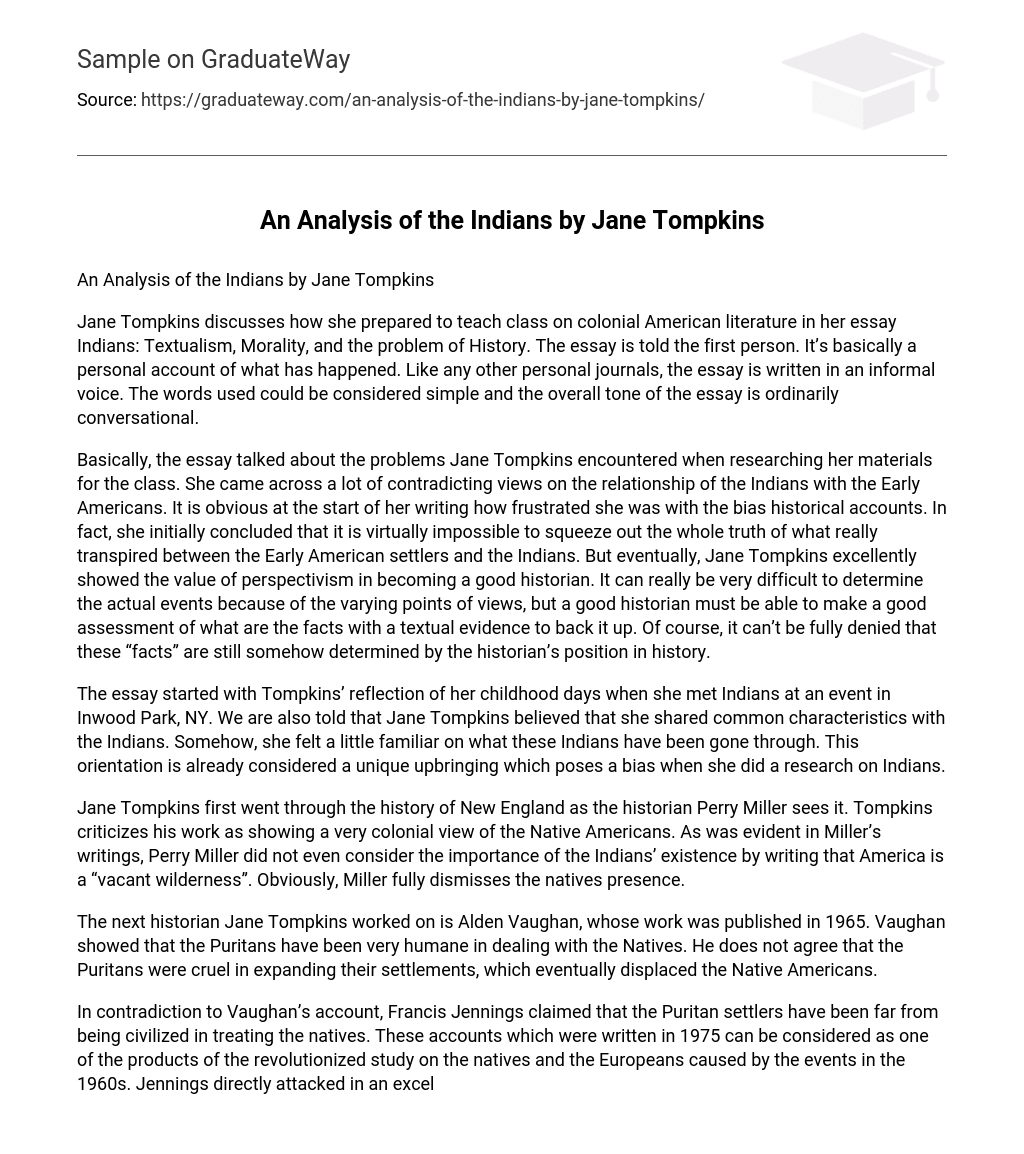Jane Tompkins discusses how she prepared to teach class on colonial American literature in her essay Indians: Textualism, Morality, and the problem of History. The essay is told the first person. It’s basically a personal account of what has happened. Like any other personal journals, the essay is written in an informal voice. The words used could be considered simple and the overall tone of the essay is ordinarily conversational.
Basically, the essay talked about the problems Jane Tompkins encountered when researching her materials for the class. She came across a lot of contradicting views on the relationship of the Indians with the Early Americans. It is obvious at the start of her writing how frustrated she was with the bias historical accounts. In fact, she initially concluded that it is virtually impossible to squeeze out the whole truth of what really transpired between the Early American settlers and the Indians. But eventually, Jane Tompkins excellently showed the value of perspectivism in becoming a good historian. It can really be very difficult to determine the actual events because of the varying points of views, but a good historian must be able to make a good assessment of what are the facts with a textual evidence to back it up. Of course, it can’t be fully denied that these “facts” are still somehow determined by the historian’s position in history.
The essay started with Tompkins’ reflection of her childhood days when she met Indians at an event in Inwood Park, NY. We are also told that Jane Tompkins believed that she shared common characteristics with the Indians. Somehow, she felt a little familiar on what these Indians have been gone through. This orientation is already considered a unique upbringing which poses a bias when she did a research on Indians.
Jane Tompkins first went through the history of New England as the historian Perry Miller sees it. Tompkins criticizes his work as showing a very colonial view of the Native Americans. As was evident in Miller’s writings, Perry Miller did not even consider the importance of the Indians’ existence by writing that America is a “vacant wilderness”. Obviously, Miller fully dismisses the natives presence.
The next historian Jane Tompkins worked on is Alden Vaughan, whose work was published in 1965. Vaughan showed that the Puritans have been very humane in dealing with the Natives. He does not agree that the Puritans were cruel in expanding their settlements, which eventually displaced the Native Americans.
In contradiction to Vaughan’s account, Francis Jennings claimed that the Puritan settlers have been far from being civilized in treating the natives. These accounts which were written in 1975 can be considered as one of the products of the revolutionized study on the natives and the Europeans caused by the events in the 1960s. Jennings directly attacked in an excellently formulated essay how, the Puritans mistreated the natives.
There are still several authors and historians whom Jane Tompkins consulted. She read Calvin Martin’s work that claimed that the highly spiritual Indians somehow got very interested in the fur trade. Another historian, however, Charles Hudson, contradicted his theories.
Because of the several history books and essays on Indians, and most of them seem contradictory, Jane Tompkins naturally got confused with all the readings. There are essays that praise the highly civilized Indian cultures that showed the Europeans their ways of life. However, there are also accounts claiming how brutal these Indians were. In fact, Jane Tompkins encountered a first-hand account by Mary Rowland of her experiences while held captive by the Indians in the 1680s.
Because of these widely varied accounts, not to mention largely opposing views, of what really happened, Jane Tompkins concluded that historians tend to tell history as they perceive it, influenced by their personal upbringing and the period of time they have lived on. It is difficult of really tell what has happened because every event is subject to the observer’s prejudices, opinions and overall frame of reference. Historians tend to omit, unconsciously or otherwise, some details to strengthen their stand on that particular issue.
The essay does not discourage anyone from learning the true history. In fact, it challenges everyone to learn how to pursue the truth. By immersing oneself in these opposing views of a singular event, one will be able to see what has really happened in a variety of angles. We won’t be able to know the full truth by just exposing ourselves to one point of view. To learn as much as possible, familiarize every versions and then just filter out the conflicting views. This would be the closest story you’ve got on the truth.





